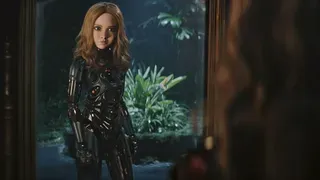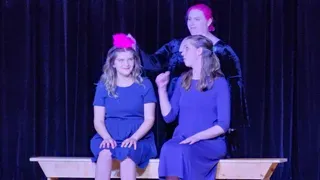June 21, 2008
Frida Kahlo
Michael Wood READ TIME: 4 MIN.
Whether they're an expression of narcissism, or represent an escape from debilitating physical pain and emotional suffering, Frida Kahlo's transfixing self-portraits - she painted at least 60 - are beguiling. They dominate Frida Kahlo, an exhibition of 42 paintings that charts the Mexican artist's career from 1926 until her death in 1954, her growing confidence as an artist and her tumultuous relationship with her on-again, off-again husband, Diego Rivera, the famous muralist whose stature and outsized reputation dwarfed Kahlo's work for many years. The marriage to a high-profile artist and that she was not only a woman but a woman of color combined to thwart her attempts to achieve recognition on her own merits.
Whoever once said that an unhappy childhood and/or a tortured existence were prerequisites for creativity must have had Kahlo in mind. By any measure, she led a tormented life plagued by chronic pain and personal disappointment. She contracted polio at age 6 which caused her to limp; at 18, her body was sundered and her back broken in a tram accident, a pivotal event followed by countless, excruciating spinal surgeries and long periods confined to bed and stuffed into medieval corsets; later, her leg was amputated to the knee. In some ways, the suffering, emotional and physical, jump-started a powerful drive that found artistic expression. The show, which devotes at least two galleries to her torments, could well have been called "The Trials of Frida".
"The only thing I know is that I paint because I need to, and I paint whatever passes through my head, without any other consideration," she said. The absence of self-censorship is particularly evident in works chronicling her ordeals and the distorted body image they produced. Not for the queasy, "Without Hope" is a vision of night terror turned daylight nightmare. As Kahlo lies helpless in bed, she is surrounded by imagery of torn flesh, a skull with her name emblazoned on it and human innards draped over the bedposts. She sucks on the tip of a funnel attached to distended organs that float above her body. "The Broken Column" is a theater of sex and suffering, sensuality and torture. Kahlo's long black hair flows over her naked torso. Her breasts exposed and upper body braced with white strips of corseting, it's as if a torturer's rack confines her torn body. She's imprisoned in a house of pain whose image arouses pleasure.
Damage done
Another gallery concentrates on the damage done by her tempestuous relationship with the promiscuous, egotistical Rivera. Following their first divorce, Kahlo poured her rage, misery and frustration into "The Two Fridas," a visceral painting of two mirror-image self-portraits seated next to each other. Linked by an artery, their hearts float outside the body cavity. One woman cuts the artery with a pair of scissors, and blood stains her white peasant dress; the other clasps a miniature portrait of Rivera in her hand. "Self-Portrait with Thorn Necklace and Hummingbird" draws a parallel between her suffering and that endured by Christ. Is she a drama queen or a martyr on the altar of love? The woman who regards us with the sphinx-like gaze tells all yet divulges little.
Kahlo was inspired by Mexican colonial painting and pre-Colombian art, references found in a number of works such as "Self-Portrait with Bed." Painted on metal like an icon, Kahlo's visage glows; in "Girl with Death Mask," a tiny jewel-like painting, a little girl in a pink dress dons a skull mask - a stunning juxtaposition - and a devil mask rests on the ground. A zesty imagination is at work in "The Suicide of Dorothy Hale," which depicts the death of a starlet who jumps to her death from a Manhattan skyscraper, passing through layers of tissue-blue clouds. Hale is captured in stages: first, plunging headlong in mid-leap; and then, again, in a pool of blood, dead on the street, a corsage pinned to her lapel. The painting was commissioned by Hale's friend, Clare Booth Luce, who reportedly was so shocked by the finished product she nearly passed out.
In the late 1930s and early 1940s, Kahlo and Rivera spent time in San Francisco, where they were married. Their license is displayed in a gallery that chronicles their visits and social life in the Bay Area.
The show concludes with the couple's private photography collection, which consists primarily of pictures of themselves with family and friends, a circle of artists and intellectuals that included Andre Breton and Leo Trotsky.
Exotic, strikingly beautiful with prominent dark eyebrows, Kahlo stares out from these snapshots and paintings with an aura of mystery and an impenetrable sadness, looking every inch the Third World Mona Lisa. It was one of several roles she played in a private drama that came to be a prison.
The show, on view at SFMOMA through September 28, is expected to be packed throughout its run. In order to provide optimal viewing, a limited number of visitors will be allowed in the galleries at one time. The Museum will be open late Thursday until 8:45 p.m., with some extended hours on weekends. For details: www.sfmoma.org or call (415) 357-4000.
Michael Wood is a contributor and Editorial Assistant for EDGE Publications.







